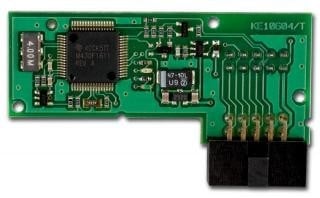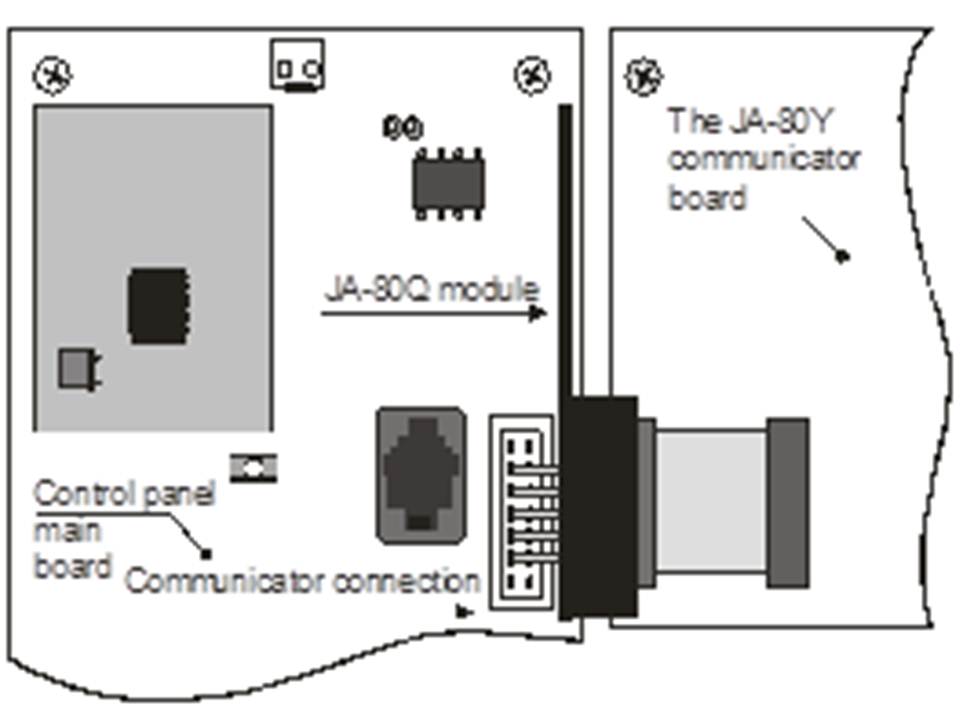JA-80Q
Too much choice? Chat or call us at 085-0160316
There are no products in these categories. Shop on.

Service explanation for JA-80Q
1 Installation in the PBX
Important: Hardware compatibility with the JA-80K central controller is from hardware version KE10104 onwards. Check the description on the main PCB of the central controller. (The version number is printed right next to the RESET jumper.)
If you purchased the module separately, it should be installed in the Oasis central controller as follows:
1. The central unit must be completely de-energised (both 230V and the battery)
2. Insert the JA-80Q module (in the central controller) into the digital bus connector designed for the (standard) JA-80Y connection
3. For parallel use of a JA-80Y module plug the communicator's connector into the contact of the JA-80Q module.

2 Teaching detectors with camera
Installation should only be done by a certified technician approved by an authorised distributor.
1. Put the switchboard in service mode and press the 1 key on the control panel to activate teach-in mode (see switchboard description).
2. Teach the JA-84P by inserting its battery (see description of the JA-80P)
3. Exit the teach-in mode of the central unit.
Note: If the detector has already been taught-in in the central unit before the JA-80Q module is inserted, you do not need to teach the detector again. You only need to activate the teach-in mode and get out again. This way, the module will obtain all relevant information from the central
3 Programming the communicator
For successful transmission to the web server which has a photo receiver programme, the server IP address must be programmed into the JA-80Y or JA-80V communicator. The address of the Jablotron photo display website is http://img.jablotron.com.
IP address is: 77.104.20.129 port 7070
1. Put the PBX in service mode.
2. Program the required IP address and port to be used to send the date to using the ComLink program (in the ARC window) or by keying in the following sequence.
013 *8 xxx xxx xxx xxx yyyy *0
Where:
xx..x is the 12-digit IP address
y..y is the 5-digit port number of the receiver. See also the description of the communicator.
Example: 013 *8 077.104.220.129 07070 *0
3. Exit the service mode of the exchange.
Important:
The setting or the change of the setting is not active until the control panel is taken out of service mode.
The information about a new picture via SMS is sent to all phone numbers that also receive the event "burglar alarm - immediate". This SMS also contains a link to the new picture on the server. This option is available on the JA-80Y from software version number XA61009 and on the JA-80V from software version number XA64005.
4 LED signals
After taking a picture of a detector, the picture will be sent to the control unit and then to the JA-80Q module via the digital bus. This is indicated by a green flashing LED. Successful transmission is confirmed by a long green flash (2 sec). Failed transmission is displayed by a series of fast green flashes at the end.
When the picture is received by the JA-80Q module, the picture is sent via the communicator to the pre-programmed web server. This transmission is indicated by a flashing red LED on the JA-80Q module. Successful transmission is confirmed by a long red flash (2 sec). Failed transmission is displayed by a series of rapid red flashes at the end.
The total time required from the time of taking the picture to receiving it on the web server is about 20 seconds. If the signal is weak, there may be a delay (due to the data being sent several times). Each photo has a date and time indication (copied from the control centre) when it was taken. It takes at least 60 minutes from the time of connection for the time of the photos to be synchronised with the PBX.
